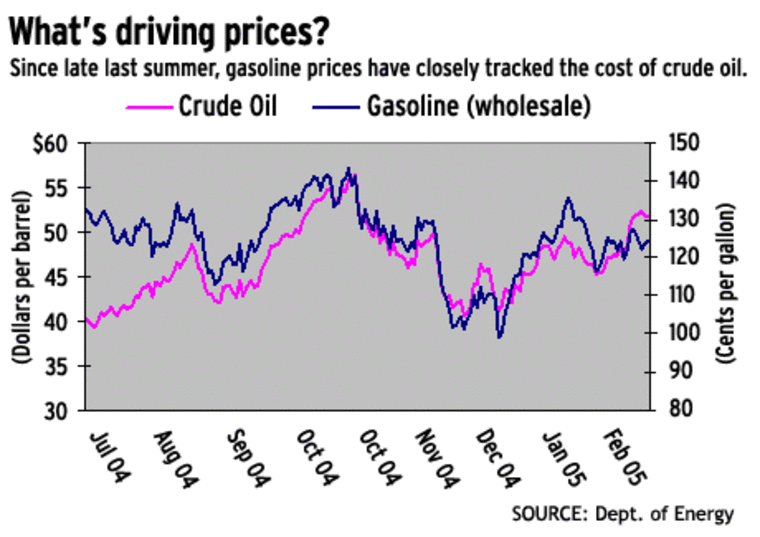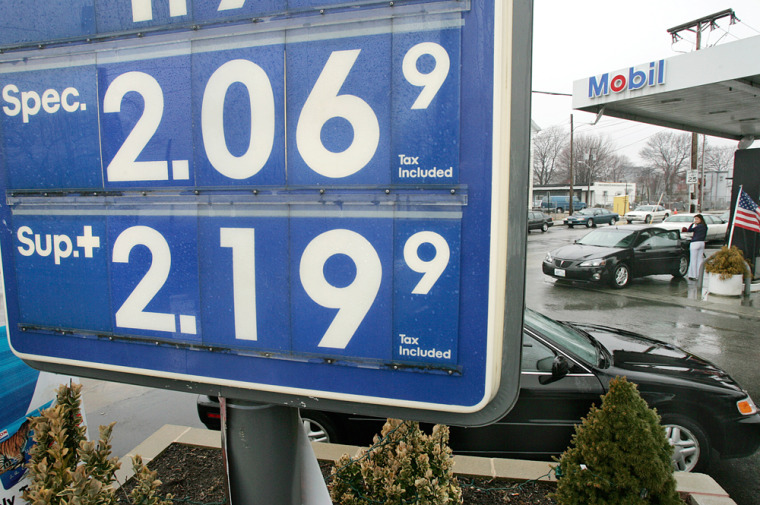With crude oil prices sharply higher than a year ago — trading near $55 a barrel on Tuesday —gasoline prices already have begun to climb. And with the winter heating season soon coming to a close, gasoline is once again the focus of attention among producers, traders and consumers. Much of this summer’s increase will depend on how much gasoline the nation’s already-stretched refineries can crank out.
But strong demand — fueled by strength in the U.S. economy — also is pushing prices higher. And despite the howls and whimpers often heard at the pump, high gasoline prices apparently have done little to reduce the American driver’s thirst for gasoline.
With the summer driving season months away, some forecasters already are warning of record prices this year. The U.S. Department of Energy is forecasting a peak average price of $2.18 a gallon in the second quarter of this year — up 22 cents from last year's second quarter.
“All of the dynamics are in place for U.S. motorists to pay new record high prices again this year,” said Geoff Sundstrom, a spokesman for AAA.
Those dynamics include growing demand worldwide, especially in rapidly developing countries like China and India. Crude oil prices — which make up about half the cost of a gallon of gasoline — have risen largely because oil producers can barely keep up with demand. And refining capacity is stretched tighter than ever, as tougher environmental regulations have made it costly to expand production. All of which makes it difficult to predict just where gasoline prices are headed.
As of last week, AAA said U.S. gasoline prices averaged $1.92 a gallon, about 22 cents higher than this time a year ago. But crude oil prices have risen even faster.
With gasoline demand coming off a seasonal winter low, retail prices have risen just 9 percent since the start of the year, while the price of crude is up 22 percent. If crude oil continues to trade above $50 a barrel, analysts expect gasoline prices to march quickly higher to catch up.
No letup in demand
Though consumers have complained loudly about gasoline price increases, there are no signs of slowing demand. That could be because, adjusted for inflation, gasoline in the U.S. is still cheaper than peak price of roughly $3 a gallon in 1981.
If gasoline demand remains strong, pump prices will depend heavily on whether producers can keep up with that demand. Refiners have already begun building up stockpiles for the summer after running at more than 90 percent capacity all winter. That’s hardly a surprise: With prices at these levels, refiners are booking big profits and trying to squeeze every drop of product they can.

“This is as good as we have ever seen it, and it’s going to get better,” Bill Greehey, the Chairman and CEO of Valero Energy, told CNBC last month when the company posted record profits of $1. 8 billion for 2004 — nearly triple the year before.
Total gasoline inventories at the end of February were 10 percent above last year’s levels and higher than they have been in 5 years. But because demand has increased, bigger stockpiles likely will be needed to get through the summer.
For truckers and owners of cars burning diesel, the news has been worse. Pump prices for diesel fuel are well above $2 a gallon — about 50 cents higher than a year ago — hitting $2.45 a gallon on the West coast.
That’s largely because supplies of diesel and heating oil have been tighter than usual, according to the Energy Department.
As the U.S. economy continues to pick up, demand for diesel — which is used to ship virtually every product made or consumed in the United States — has picked up as well. Though demand for gasoline and heating oil typically slows at this time of year, so far it has shown no signs of letting up.
All of which is expected to put a strain on the world’s refining capacity, according to a recent report by the International Energy Agency. Construction of new refineries and expansion of existing plants is expected to raise refining capacity by over a million barrels per day, the agency said. But it expects oil demand this year to grow by 1.44 million barrels a day.
